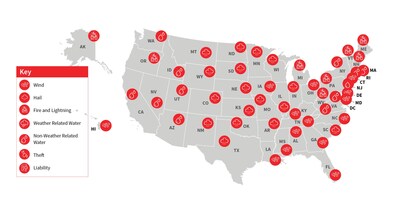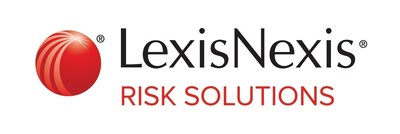LexisNexis U.S. Home Trends Report Highlights Impact of Severe Storms as Catastrophic Claims Climb to Record Levels
Rhea-AI Summary
LexisNexis Risk Solutions has released its ninth annual U.S. Home Trends Report, providing insights into the home insurance industry. Key findings include:
- All Peril loss cost and frequency increased by 4.1% and 11% respectively from 2022 to 2023, and by 52% and 16.9% since 2019.
- Catastrophe claims represented 46% of all claims in 2023, the highest in seven years.
- Hail loss cost increased 57.9% since 2022, with frequency up 53.6% and severity rising 2.8%.
- States with the highest impact of hail-related perils include Colorado, Nebraska, and Wyoming.
- Loss costs for Fire and Lightning (-11.1%) and Weather-Related Water (-51.4%) declined from 2022-2023.
The report highlights the impact of severe storms and historic-level weather disasters on rising insurance premiums, emphasizing the need for insurers to understand by-peril trends and maintain extensive data to remain competitive in a volatile market.
Positive
- All Peril loss cost and frequency increased by 4.1% and 11% respectively from 2022 to 2023
- Hail loss cost increased 57.9% since 2022, with frequency up 53.6% and severity rising 2.8%
- Non-Weather-Related Water loss cost decreased by 11.2% from 2022-2023
Negative
- Catastrophe claims represented 46% of claims across all perils in 2023, the highest in seven years
- Loss cost for Fire and Lightning declined 11.1% from 2022-2023
- Weather-Related Water loss cost decreased by 51.4% from 2022-2023
- Severity remains 29.8% higher than 2019 figures despite a 6.3% decline since 2022
Insights
The 2024 LexisNexis Home Trends Report reveals significant challenges for the U.S. home insurance industry. The 4.1% increase in all-peril loss cost and 11% rise in frequency from 2022 to 2023 indicate growing risks and potential profitability pressures for insurers. The 52% increase in loss cost since 2019 is particularly alarming, suggesting a long-term trend that may require substantial premium adjustments.
Catastrophic claims reaching 46% of all claims in 2023 - a seven-year high - highlights the increasing impact of severe weather events on insurers' bottom lines. The 57.9% surge in hail loss cost is especially noteworthy, potentially leading to significant rate increases in affected states like Colorado, Nebraska and Wyoming.
While some perils saw decreases (e.g., Fire and Lightning, Weather-Related Water), the overall trend remains concerning. Insurers will likely need to reassess their pricing models, risk assessment strategies and potentially their geographic exposure to maintain profitability in this volatile environment.
The report underscores the growing influence of climate change on the insurance industry. The record-breaking 28 weather and climate disasters exceeding
The significant variations in loss cost and severity across states highlight the need for more granular, location-specific risk assessment. Colorado's 274% above-average catastrophic loss cost and Hawaii's 63% above-average severity demonstrate the localized nature of climate risks.
Insurers must invest in advanced climate modeling and data analytics to accurately price risks and manage exposure. The industry may also need to collaborate with policymakers on resilience measures and explore innovative risk transfer mechanisms to remain viable in high-risk areas. This climate-driven volatility could lead to reduced coverage availability in certain regions, potentially creating protection gaps.
2024 LexisNexis Home Trends Report highlights why home insurance has increased for homeowners as loss costs across all perils rise for the fifth year in a row
Key Takeaways
- All Peril lost cost and frequency increased by
4.1% and11% , respectively, from 2022 to 2023 and52% and16.9% , respectively, since 2019. - While severity has declined
6.3% since 2022, it remains29.8% higher than 2019 figures. - Catastrophe claims represented
46% of claims across all perils combined in 2023, the highest in seven years. - Hail loss cost increased
57.9% since 2022, along with frequency (up53.6% ) and severity rising2.8% year over year from 2022. States with the highest impact of hail-related perils includeColorado ,Nebraska andWyoming . - Lost cost for other weather-related perils declined across Fire and Lightning (down
11.1% ) and Weather-Related Water (down51.4% ) from 2022-2023. Non-Weather-Related Water loss cost decreased by11.2% in the same period but remained on an upward trend over the past seven years.
"In the last year, the
All Peril Trends
- The
U.S. home insurance industry has experienced an upward trend in loss cost across all perils combined over the past seven years. These figures include all perils highlighted below: hail; wind, water, fire and lightning; and non-weather related claims such as water leaks, thefts or liability. - Despite the severity reduction in 2023 (
6.3% down from 2022), severity's elevation above 2019 (up29.8% ) points to the importance of long-term trend data when evaluating risk and pricing. Colorado ranks highest in loss cost from catastrophic claims (274% above 2023 U.S. average catastrophic loss cost), while the severity of claims (dollars lost, on average, per claim paid) inHawaii was well above any otherU.S. state in 2023 (63% above 2023 U.S. average severity).U.S. states with the highest combined catastrophe and non-catastrophe loss costs include Colo., Minn., Neb., La. andIowa . Lowest ranking states include Mass., N.H., W. Va., Vt. andMaine .
A Year of Hail
- In 2023, the
U.S. experienced 6,962 hail events, up57.3% from 2022, with71% of hail claims deemed catastrophic. - With 28 weather and climate disasters in 2023, each surpassing the billion-dollar damage threshold, 17 were attributed to severe weather or hail events.
- Hail peril seasonality over the past seven years continues, with April, May and June observing the highest frequency and loss cost in 2023.
Wind, Water, Fire and Lightening Perils
- Wind peril frequency rose
14.8% , along with a loss cost increasing0.7% from 2022-2023. Severity, by comparison, fell12.3% year-over-year. Despite seasonal loss cost averages peaking in August and September over the past seven years, 2023 loss cost and frequency were highest in March. - In 2023,
62% of Wind claims were deemed catastrophic claims, up from52% the year prior. - Fire and Lightning perils in 2023 saw decreases across loss cost (-
11.1% ), frequency (-8.6% ) and severity (-2.7% ) from 2022. However, catastrophic claims rose7% from 2023, with the wildfire on the island ofMaui, Hawaii , being one of the most damaging and deadly events in 2023. - Weather-Related Water perils declined in 2023 with a reduction in loss cost (-
51.4% ), frequency (-25.5% ) and severity (-34.8% ). In 2023,61% of weather-related water claims were catastrophic.
Non-Weather-Related Perils
- Addressing claims related to water damage, such as leaking pipes and appliances, Non-Weather-Related Water perils decreased across loss cost (-
11.2% ), frequency (-10.3% ) and severity (-1.1% ) in 2023. - While Theft loss cost and frequency decreased by
14.2% and15.8% , respectively, in 2023, severity rose by1.9% , partially attributed to the rising cost of consumer goods such as high-end kitchenware. - Despite the marginal increase in severity (
0.2% ), Liability peril decreased regarding loss cost (down18.2% ) along with frequency (-18.3% ) in 2023. - Other perils, including physical damage claims not included elsewhere, extended coverage, damage to property of others, etc., saw a frequency increase of
9.3% year-over-year. Loss cost, along with severity, both declined10.7% and18.3% , respectively, from 2022 to 2023.
"When we look at peril data over a seven-year span, it's increasingly clear that home insurers cannot rely on short-term trends alone to make fully informed decisions about their books of business and operational strategies," said George Hosfield, associate vice president, home insurance, LexisNexis Risk Solutions. "For example, while hail loss cost surged by
Download the latest LexisNexis
About LexisNexis Risk Solutions
LexisNexis® Risk Solutions harnesses the power of data, sophisticated analytics platforms and technology solutions to provide insights that help businesses across multiple industries and governmental entities reduce risk and improve decisions to benefit people around the globe. Headquartered in metro Atlanta,
Media Contacts:
Chas Strong
LexisNexis Risk Solutions
Phone: +1.706.714.7083
Charles.Strong@lexisnexisrisk.com
![]() View original content to download multimedia:https://www.prnewswire.com/news-releases/lexisnexis-us-home-trends-report-highlights-impact-of-severe-storms-as-catastrophic-claims-climb-to-record-levels-302277309.html
View original content to download multimedia:https://www.prnewswire.com/news-releases/lexisnexis-us-home-trends-report-highlights-impact-of-severe-storms-as-catastrophic-claims-climb-to-record-levels-302277309.html
SOURCE LexisNexis Risk Solutions










